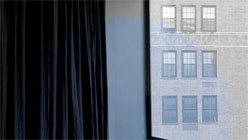Like the Olympics, only twice as frequent, every two years the Whitney Biennial promises a fresh take on the same events. Only this time with new, exciting talent. It is hard to overlook the spectacle, and it usually doesn’t disappoint. At the very least, there is something for everyone.
This year marks the Biennial’s seventy-sixth year. Fifty-one artists have been culled by the curating team of Elisabeth Sussman, a long-time Whitney curator of photography, and Jay Sanders, a freelance writer and curator. The exhibition uses four of the museum’s five floors, taking up about 6,000 square-feet. Unique to this run are the number of filmmakers included the show (dance and performance are also well represented), as well as the general tone of politically and socially conscious work.
No doubt, it is a difficult task to assemble such a broad survey, but I found 2012 to be uneven and underwhelming. There were some bright spots, highlighted below.
1. Dawn Kasper is an LA-based artist who has moved into the Whitney for the three-month run of the Biennial. Taking her possessions along with her, she has been inhabiting a very messy, cramped area of the third floor since mid-February. Her piece, This Could Be Something If I Let It, is an evolving performance of sorts, as Kasper will make work, play music, hold studio visits, and engage with viewers during museum hours. Kasper herself is incredibly convivial (“Hi, I’m Dawn!” she says eagerly, introducing herself), but the work itself is decidedly darker. I can’t help feeling as though it speaks to the circus-like quality that artists are subjected to in the “selling” of their work, as well as the nomadic lifestyle that the job demands.
2. Latoya Ruby Frazier is a young photographer who hasn’t had much exposure before this exhibition. She has several projects on the exhibition’s second floor, a plum spot in the museum. In Campaign for Braddock Hospital (Save Our Community Hospital) (2011) and Homebody (2010), the artist has used her hometown of Braddock, PA — an old steel town that has faced tremendous economic hardship for decades — as her subject. In the former piece, “campaign” is a play on words; the artist has used images from a recent Levi’s jeans print campaign that was photographed, of all places, in Braddock. Frazier writes politically charged comments on top of the advertisements, which picture wild, carefree youths under slogan’s like “go forth” and “everybody’s work is equally important.” Homebody is a series of Francesca Woodman-esque self portraits in which Frazier dons the pajama’s and blankets of her deceased step-great-grandfather, who suffered and died from a chronic illness as a result of working in the steel plant. Frazier, it’s worth mentioning, is one of the few African Americans in an otherwise none-too-diverse show.


